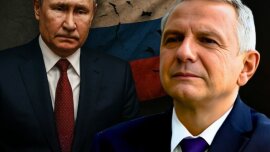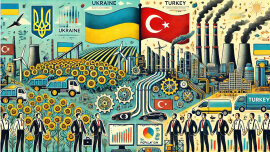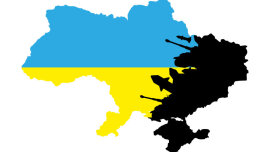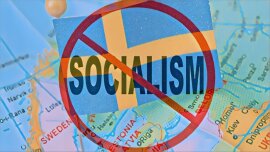Poland delights and revolts, inspires and infuriates, makes you fall in love and cuts you down. Totalitarians, Nazis and Russians hate her. Democrats, humanists and liberals adore her. Pole Pope John Paul II made a huge contribution to the liquidation of the most bloody, aggressive and dangerous Evil Empire in the history of mankind - the USSR. Pole Lech Walesa from a simple electrician became the leader of the European movement to cleanse the world of Soviet totalitarianism. Poles Czesław Milosz, Wislava Szymborska, Olga Tokarczuk are the world elite of literature and culture in general. The Poles Andrzej Wajda, Krzysztof Keslowski, Janusz Kaminsky are the golden treasures of world cinema. In the Hall of World Fame for Economic Reformers, the name of Leszek Balcerowicz shines brightly.
History arranged cruel, bloody trials for the Poles. Dismemberment with liquidation, raids with occupation, Nazi exploitation, forced Sovietization, denial of reparations, fabrication of history, liquidation of private property, demonization of churches, discrediting of heroes, social deprivation, waves of emigration - the Poles survived, endured, went through everything.
In the late 1980s, the Poles won history's chance to become truly free, independent and democratic. They didn't miss him. Moreover, in front of Poland, no one paved the way with roses to a new economy, private property and open competition and new institutions of the state. No one gave clear instructions on how to move from Soviet, state planning slavery to capitalist freedom. He did not distribute subsidies and soft loans to keep the industrial giants of the Soviet era afloat. There was no single information point for explaining to people how to be and how to understand power. As well as there was no button "scoop in the head to zero."
Poland has been a pioneer in systemic transformations. Neither Western academics nor foreign consultants were prepared for the collapse of the Soviet totalitarian system. They did not have ready-made recipes for such a historical transformation. Therefore, Poland has filled a lot of cones, stepped on so many rakes that it is more than enough for the whole of Europe. The more valuable is her experience. It is wise to carefully study it, because the Polish reforms are rightfully considered one of the most successful in the post-Soviet space. Such knowledge is indispensable for minimizing transformation costs.
Let's remember how it all began
The Mazowiecki-Balcerowicz team, under the political mandate of L. Walesa, began with the liberalization of commercial activities and prices. The beginning of reforms can be considered the year 1990, when obstacles to foreign trade were eliminated, and a fixed exchange rate of the zloty was introduced. The Poles began to create a new, their own national structure of the economy. For them, no one cleared the Augean stables of the old Soviet state plan. It was necessary to create a new one not from scratch and not by civil servant angels. Millions of old nomenklatura, party and ideological cadres have not disappeared anywhere. The new ministers, deputies, and managers were also left with a detailed terms of reference describing the action plan and sources of income in an envelope. It was a unique historical period of learning by doing.
Price liberalization is a must for systemic transformations. Prices in the Scoop/Gosplan model are conditional units of account. They turn investors, producers, lenders and consumers into blind kittens. That is why they need to be liberalized, made market-oriented. This is not a whim of liberals or the West. This is an element of basic economic hygiene. It is like first aid to a patient with open bleeding. L. Balcerowicz and his team understood this very well. Therefore, they did everything to convince politicians of this. Not everything went smoothly. Even in the late 1990s, the share of state-regulated prices in the basket of goods for which inflation is calculated (CPI) was 10.6%.
Inflation peaked in Poland in 1989 (251%) and 1990 (586%). After that, inflation began to decline. In 1991 was already 70.3%, in 1992. – 43%. Poland achieved real price stability when Leszek Balcerowicz became the head of the National Bank. In 2001 annual inflation was 5.5%, and then for more than 20 years its average annual level did not exceed 3%.
Recall the main provisions of the Balcerowicz plan:
1) liberalization of prices and foreign trade;
2) deregulation of business relations and provision of dynamic rather than static property rights;
3) industrial restructuring, the components of which were privatization, disaggregation, corporatization;
4) significant reduction or elimination of subsidies and subsidies;
5) zloty convertibility based on a fixed exchange rate;
6) balancing the budget;
7) the abolition of "easy" and cheap loans for state enterprises and agriculture"
After the start of far from the most systemic, deep reforms, the recession in the Polish economy lasted only two years. GDP in 1990 decreased by 7.2% in 1991. – by 7.0% After that, growth began. In 1992-2001 the average annual growth rate was 4.7% of GDP, in 2002-2011. - 4.2% of GDP, in 2012-2021. – 3.4% of GDP. For 30 years, from 1992 to 2021, the average annual growth rate of the Polish economy amounted to 4.1% of GDP. For comparison, the world average rates were 3.4%, and in Ukraine - minus 1.0% of GDP. As we can see, in itself, membership in the EU since 2004. did not add to the growth rate of the Polish economy.
In the early 1990s, Poland, having no rich experience in harmonizing monetary and fiscal policy, made many mistakes in this area. One of these was the introduction of currency convertibility based on a fixed nominal rate in an environment of high inflation and unbalanced foreign trade. Foreign consultants insisted on a fixed exchange rate. This regime led to the fact that the purchasing power of the Polish zloty increased eight times compared to the main currencies of the world. The exchange of foreign currency for złoty, opening deposits in Polish banks and then converting them back allowed external "investors" to receive 10-20 times more income than as a result of traditional financial transactions in stable markets.
During the first two years of such a regime, only the payment of interest from the reserves of the National Bank amounted to $2.4 billion. The loss of capital was much higher than the volume of foreign direct investment. At the same time, the sharp appreciation of the Polish currency led to an increase in the volume of cheap imports and the bankruptcy of thousands of enterprises. Subsequently, in 1995, the regime would be changed to a managed float within a fixed corridor. In 2000, Poland switched to a free floating monetary regime.
Privatization and the size of the state
Privatization is also a must for creating a full-fledged market structure of the national structure of the economy. In 1990 The Poles passed the Law on Privatization in the early 1990s. We started with the sale of small state-owned enterprises. At the start, there were 8441 state-owned enterprises in the country. By the end of 1994, 4,722 or 56% had changed their form of ownership. Small-scale privatization ended only by 2000. It should be noted that, unlike Ukraine, there was a private sector in socialist Poland. In 1989, its share of the private sector as a whole (including agriculture without cooperatives) in the creation of national income was 19.2%. The share of the private sector outside agriculture was 9.2%.
The result of small-scale privatization for 1990-1992. there was a change in the form of ownership of almost 53 thousand small enterprises, almost 122 thousand real estate objects, including housing. By the end of 1992, more than 90% of the total number of people employed in domestic trade worked in private enterprises. Large privatization proceeded much more slowly. Up until 1995 there was no talk of privatizing the main state-owned banks. Clearly unequal economic conditions were created for private banks. The large state-owned agricultural Bank Gospodarki Żywnościowej went bankrupt, but was rescued by the state. $700 million was spent to compensate for the losses. Restructuring without privatization cost taxpayers more than one billion dollars. This bank was sold to BNP Paribas only in the second half of the 2010s.
In the history of Polish privatization, there was a very revealing fragment under the Minister of Finance G. Kolodko (1993-1997). He decided not to privatize state-owned enterprises, but to corporatize them, strengthen control over their work, improve their efficiency, and only then privatize them. Poland has spent more than $5 billion to rehabilitate unprofitable state-owned enterprises, but the structural problems have not been resolved. From 1996 to 1999, the share of the private sector in GDP did not change, being at the level of 65%. By the beginning of 2002, 2054 companies were still in the hands of the state.
At the beginning of the 2020s, there were about 440 state-owned and state-controlled commercial enterprises in Poland. Among the top 50 Polish companies by revenue, twenty are state-controlled (40%). They employ 56.3% of the employees of the Top 50 Polish companies. The public sector in Poland is larger than in the Czech Republic, Romania, Hungary and Slovakia. This is obviously why Poland's fixed capital investment is still lagging behind the EU leaders. In 1991 they accounted for 12% of GDP, in 2021. - 18%. For comparison, in the Czech Republic they amounted to 27%. For over 30 years, the Czech Republic has, on average, invested 9 percentage points more in fixed capital than Poland. This is one of the factors why GDP per capita in the Czech Republic in 2022. amounted to $27613, and in Poland - $18280. In 2004 , in the year of accession to the EU, GDP per capita for Poland was $6685, for the Czech Republic - $11752. In the private sector, investment in fixed capital accounted for only 10%. The EU average is 13% of GDP. The Poles lag behind the leaders of Europe (Estonia, Switzerland) by 10 p.p.
Revenues and expenditures of the State
Poland chose the EU tax legislation as a model, ignoring the historical experience of the development of developed countries, which at the stage of formation had extremely low tax rates and the minimum necessary set of state regulation tools. In 1993 Poland introduced VAT. State revenues, despite the high tax rates, declined. Fiscal populism clearly slowed down the country. In 1992, social spending accounted for 56% of government spending, and in 1993 it increased to 60%. If Poland had not been forgiven for half of the accumulated public debt, then economic development would have been much slower.
Poland only at the very beginning of the 1990s tried to limit the size of public spending, but this was not possible due to an acute shortage of political will and fiscal unbridledness. So in the period 1995-2000. average annual expenditures of state administration bodies amounted to 45.6% of GDP, in 2000-2005. - 44.3% of GDP. During this period, Poland has never, not a single year had a balanced state budget. After joining the EU, Poland's government spending has never dropped below 40% of GDP, in 2019-2022. were confidently more than 45% of GDP. During the EU membership (2004-2022), the average annual expenditures of the Polish public administration amounted to 41% of GDP. The Poles have never balanced their state budget. The average annual budget deficit of the general government sector in 2004-2022. amounted to 3.6% of GDP. It should be noted that the Poles were quite disciplined in their attitude to the public debt. In 2004, in the year of accession to the EU, it amounted to 45.1% of GDP, in 2022. - 49.6% of GDP. Only in 2004 Poland's GDP was $255.3 billion, and in 2022. - $688.3 billion, 2.7 times more. Private debt (of the corporate sector) is much larger. In 2022 it amounted to 120% of GDP.
Poland today. Lessons for Ukraine
In 2023 75% of Poles are satisfied with their lives. For comparison, in 1990. there were 39% of them. 81% of Poles are satisfied with personal relationships, 73% are satisfied with their work, 63% - with the state of their finances.
In 2022 In Poland, there were 4 times more people with higher education than in 1990. PISA results in 2022 amounted to 516 against 474 in 1990. In 2022 compared to 1990 50% less income inequality, 20% fewer people living below the poverty line. Life expectancy has increased by five years. There were 43% fewer murders.
Poland's weaknesses are the poor quality of public administration (World Governance Indicators). According to the six parameters of this index, Poland has one of the worst performances in the European Union. In the 2022 Corruption Perceptions Index. Poland took 55th place. According to the Property Rights Protection Index 2022, it was in 53rd place, and in the Fraser Institute Economic Freedom Index 2022, Poland took a distant 80th place.
There is no doubt that Poland has passed the period 1991-2022. quite successfully. The replacement of the Sovok/Gosplan model with the model of the State of General Interventionism is progress. However, Poland did not become a Slavic tiger. It did not, because the political, economic and intellectual elites were stuck in the philosophy and ideology of collectivism, dirigisme and state interventionism. For very short periods in the 1990s, the country did not have a full-fledged free market liberal party in power. in the 2023 parliamentary elections. it will be a success if in the Polish parliament (Sejm) the liberal party gets 15% of the seats.
A frivolous attitude to the institutions of freedom for more than 30 years has led to the fact that in terms of GDP per capita ($18,280) Poland was outstripped by the Czech Republic ($27,613), Slovakia ($20,890), Slovenia ($29,502), Estonia ($28,631), Lithuania ($25,036), Latvia ($22,348) and Croatia ($18,427). In 2023 even Romania, which was an outsider of reforms, can show a better GDP per capita than Poland.
Our western neighbor benefits from a capacious domestic market, developed infrastructure and high-quality human capital. It is actively developing EU funds, but there are postponed reforms of the public administration system, privatization, improvement of the competition regime and reform of the so-called social sectors ahead. With the current demographics and stated commitments, the government will inevitably have to reconsider public spending.
It is definitely impossible to call individual changes in the system of education, health care and pension provision successful. The dominance of the economic populists of Poland's leading political parties poses a threat of macroeconomic destabilization. This has already manifested itself in high inflation, the unreasonable distribution of social benefits and the worsening of the debt position. It will not be easy to cope with the chronically high demands of Polish small farmers, especially if Ukraine joins the EU.
Ukraine should not blindly copy the current Polish institutions of economic policy. The bureaucracy in Ukraine is even worse than in Poland. In terms of the quality parameters of public administration, we are also getting sadder. It is better to keep silent about the judicial system, customs and control bodies. Schematosis/Oligarchy in Ukraine leaves no chance for small businesses, which managed to occupy their niches in Poland. Ukraine does not come close to having such powerful ties with the EU/USA as Poland. And this is access to foreign markets, large investors and international programs.
Poland has integrated and continues to integrate into global and regional value chains, offering access to the EU market, legal institutions, predictable macroeconomic stability and NATO security. There is none of this in Ukraine. Therefore, we cannot behave the way Poland does, and Ukraine's success is a bet on freedom. This is axiomatic. Therefore, it is necessary to do things differently than the current Polish authorities. Their policy is not much different from the typical European state of general interventionism. It is necessary, at least, to take the bar of Leszek Balcerowicz of the early 1990s, when he did everything he could, within the framework of very limited powers. Polish business will be happy to come to Ukraine if we have an innovative monetary, fiscal and regulatory policy. The Poles are well aware of both the Western world and our post-Soviet institutions. If we surprise/convince them with multi-currency rather than hard currency restrictions, if we delight/lure them with a tax system without VAT and income tax, if Poles get a status in the labor market equal to Ukrainians (so as not to go through the existing suffocating migration procedures), then our chances of country success will increase dramatically. We have a lot in common. Together we can really take off very quickly. The Poles are ready. The ball is on the side of the Ukrainian authorities. If they give the Poles a pass for state programs and nomenklatura brawls, this chance will be lost. then our chances of country success will increase dramatically. We have a lot in common. Together we can really take off very quickly. The Poles are ready. The ball is on the side of the Ukrainian authorities. If they give the Poles a pass for state programs and nomenklatura brawls, this chance will be lost. then our chances of country success will increase dramatically. We have a lot in common. Together we can really take off very quickly. The Poles are ready. The ball is on the side of the Ukrainian authorities. If they give the Poles a pass for state programs and nomenklatura brawls, this chance will be lost.

























